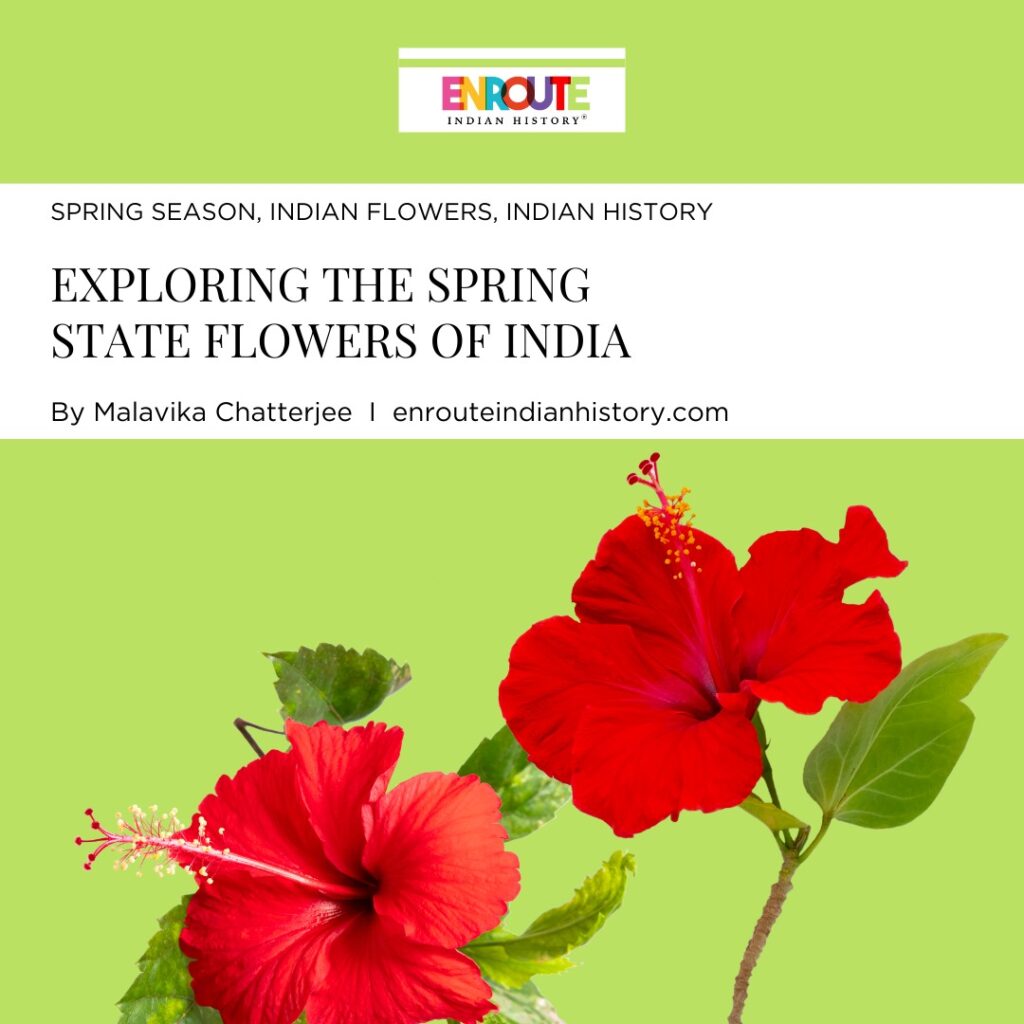
The season of Spring ushers in a warmer climate while painting the landscape with a myriad of colours. It provides much-needed relief from the frigid temperatures of the winter and comfortably braces us for the upcoming summer. The spring season is the blooming season for a plethora of vibrant flowers, making this one of the prettiest seasons to witness unfurl.
Vasanta Ritu
The spring season in India, is short, from March to April and rarely till May. However, it can span from the end of February to mid-May. Astronomically, it commences after the March/Vernal Equinox, where day and night are almost the same. This season is ideal for plants to blossom as it has pleasant weather, optimal temperature and ample sunshine. Moreover, plants have a genetic timekeeping mechanism that signals them to wake up from the cold and long nights of winter to the warm and longer days of the spring season (Heo and Sung 2011; Thomas 2017).
Seasons and seasonal changes are a recurring theme of artistic expression. From Kalidasa to Raja Ravi Varma to Rabindranath Tagore and many more, the spring season finds a place in every artistic impression. Kalidasa describes spring in the Ritusamhara (English translation by R.S. Pandit) as:
“The warrior spring comes completely armoured
my love, armed with spiky shafts of mango blossoms
his burnished bowstring made of humming bees
he pierces the hearts of lovers with his flower arrows”.
The spring season holds a special place in the Indian culture with the prevalence of many springtime-related festivals. They are mentioned in various Sanskrit texts like the Puranas and ritual texts; plays like Ratnavali; and stories like the Kathasaritsagara and Vikramcarita, to name a few (Anderson 1985). Every region or state has a different version of its celebration like Poila Boisakh (West Bengal) and Bohag Bihu (Assam) in eastern India, Vishu (Kerela) and Ugadi (Karnataka) in southern India, Kawant (Gujarat) and Gangaur (Rajasthan) in western India, and Baisakhi (Punjab, Haryana) in northern India, to name a handful.
State Flowers of India
The national flower of India, the mesmerising lotus, generally blooms in summer. It is a sacred and religious symbol in Hindu and Buddhist cultures associated with enlightenment and purity. It is also the state flower of Karnataka. All 28 states and seven Union territories are assigned a flower as part of the list of state characters and unique symbols representative of geo-political boundaries. The following seven flowers are not only native to India (South Asia) but only bloom in the spring season.
Ashoka Tree
The Ashoka Tree (Saraca asoca), or the Sorrow-less tree, is the state flower of Odisha. It bears bright orange-yellow flowers that typically bloom between February and April and is sacred in Hindu and Buddhist cultures. This tree finds mentions in the Ramayana, Kalidasa’s poems and literary works, and foreign traveller’s accounts of ancient India (Biswas and Debnath 1972). In Ramayana, there is a reference to aśokavanikā (garden) in Lanka, possibly lined with Ashoka trees (Pieruccini 2016). Kamdev, the Lord of Love, is prominently associated with the spring season, and his arrows are composed of five types of flowers, one of them being the Ashoka flower (Dwivedi 2010, p. 5). Additionally, it is one of the flowers offered to Lord Vishnu (Dwivedi 2010, p. 4).

Ashoka Tree Flower
Source: https://www.naturenursery.in/product/sita-ashoka/
Popular for its ethnopharmacological properties and commonly associated with eroticism, fertility and chastity (Anderson 1985), the Ashoka tree is highly valued for its medicinal benefits, both for physical and mental ailments throughout Indian history (Biswas and Debnath 1972; Singh et al. 2015; Rasekar and Shahi 2022; Urumarudappa et al. 2023). One of the earliest mentions of this tree is possibly from the Caraka Samhita, which notes its astringent and analgesic properties (as mentioned in Biswas and Debnath 1972). The festival of aśokāstamī (still celebrated in India) entails the drinking of eight buds of the Ashoka tree and is called aśokālikābhaksana, a term mentioned in the 14th century Smrtikaustubha by Nantadeva (as cited by Anderson 1975). This practice was a prescribed remedy to rid oneself of grief. The flowers are recognised to cure syphilis and biliousness (Begum et al. 2014).
Another custom associated with this tree is aśokādohada. In Ratnavali and Malavikagnimitram, the woman protagonist kicks the Ashoka tree to help it blossom and kickstart spring. This ritual popularised the concept regarding spring involving the union of women and trees, essential for fertility. The bark of the Ashoka tree has properties which help with gynaecological issues (Biswas and Debnath 1975). It can treat dysmenorrhea and other disorders of the uterus, intestinal problems, and kidney stones, to name a few (Begum et al. 2014). This valuable tree is still used by companies like Himalaya, Hidco, and Hamdard, among many others (Singh et al. 2015). However, its numbers are dwindling due to habitat loss, and immediate conservation measures should be adopted (Urumarudappa et al. 2023).
Flame of the Forest
The vibrant orange to scarlet flowers of the Palash tree (Butea monosperma) are a treat to the eyes. Aptly called the Flame of the Forest, these flowers bloom early in the spring season between February and April. The flowers also come in yellow, white and blue variants, which are rare. The Palash is the state flower of Uttar Pradesh, Madhya Pradesh and Jharkhand.

Palash Tree Flower
Source: https://www.telegraphindia.com/my-kolkata/places/palash-flower-season-in-full-bloom-in-bengal-photogallery/cid/1855375?slide=2
The Palash tree is considered a manifestation of the Sun God Agni. Further, the flower is offered to Goddess Saraswati as these brilliant scarlet beak-shaped flowers embody wisdom, knowledge and learning. It is believed, that one can wash away all their sins just by glancing or touching the tree (Dwivedi 2010, p. 9). According to the Puranas, the flower is like Bhramaswaroop, identical to Brahma (Dwivedi 2010 p. 8). Furthermore, it is a sacred tree because of the specific structure of the leaves, a tri-foliate formation, which represents the Hindu holy trinity of Vishnu, Brahma and Shiva (Dwivedi 2010, p. 8). Traditionally, Palash twigs were thought to possess powers of fertility and were used as ‘May-boughs’ (Anderson 1975). Here again, the concept of dohada, where a woman strikes a tree for it to blossom, takes a different shape, wherein she strikes her lover with a twig (Palash or Mango).
The palash tree has both ceremonial and medicinal uses. The flowers decorate chariots used in marriages, while its powdered form is a natural colour during Holi (Dwivedi 2010). The wood (dried twigs and bark) is ideal for sacrificial fire or to make utensils and other items for sacred ceremonies and purposes (Dwivedi 2010). Palash improves digestion and increases appetite, improves sexual vigour, and helps reduce ulcers, swelling, piles and parasitic infections and is highly useful in repairing fractures. Charak Samhita and Sushrut Samhita enumerate various uses of this tree (Dwivedi 2010), highlighting its significance. Almost every part of this tree is beneficial for various purposes in traditional medicines, Unani medicine, and homoeopathy (Saroj and Shah 2023). The leaves can make plates, cups, and roll biddies (local cigarettes); for packaging and to cure colds and coughs; the flowers are used in pesticides or as a natural dye; the tree produces an alternative to kino gum and is used both topically or ingested for various ailments (Singh and Srivastava 2022).
Nag Kesar

Nag Kesar
Source: https://seed2plant.in/products/nagkesar-plant
Ceylon Ironwood or Cobra Saffron (Mesua ferrea) is the state flower of Tripura. The white fragrant flowers of this tree usually bloom in the late spring season between April and June. According to Ayurveda, Nagkesar helps with bleeding disorders by reducing one’s Pitta, which maintains the heat imbalance. Research by Chanda et al. 2013 showed the presence of essential oils within the seed whose extract could help against the fast “emerging drug-resistant microorganisms”. This seed oil is known for its antiseptic, anti-microbial and antifungal properties and reduces inflammation, helps with asthma, and treats piles, to name a few uses (Anandakumar et al. 1986; Chanda et al. 2013; Muhammad Asif et al. 2017; Arora et al. 2019; Chakraborty et al. 2023). This wonder plant can help with a simple hiccup to sweating and body odour, and reduce vomiting and dysentery, or cancer (Muhammad Asif et al. 2017). Traditionally, a concoction of various herbs, including the Nagakesara, was used as an oral contraceptive (Bhatt and Deshpande 2021).
Pride of India
Maharashtra’s state flower is the Jarul or Queen’s Flower (Lagerstroemia speciosa). These beautiful purple, lilac and pinkish-violet flowers appear late in the spring season between April and June. Their exquisite colours make these trees popular as avenue trees. Alternatively known as Banaba, perhaps the earliest mention of this tree and its medicinal properties comes from the Ayurvedic text of Bhavaprakash Nighantu, which notes its anti-diabetic properties (Choudhury 2010). According to Klein et al. 2007, this flower has insulin receptors that help with diabetes and fight against obesity (Jayakumar et al. 2014; Miura et al. 2012).

Pride of India: Jarul
Source: https://nssiitbblog.wordpress.com/2019/07/06/6-pride-of-india-an-outstanding-summer-bloomer
Night Jasmine
When you think of Jasmine, you think of its heady floral aroma. The Night Flowering Jasmine, or Shiuli (Nyctanthes arbor-tristis), is the state flower of West Bengal. This white fragrant flower has an orange-red centre and droopy petals, further fortifying its name: Tree of Sorrow. It generally blooms late in the spring season and only at night.

Night Jasmine
Source: https://www.amazon.in/CESTRUM-NOCTURNUM-BLOOMING-Night-Scented-Jessamine/dp/B071KYW6X2
The Puranas and the Mahabharata have mentioned this flower. The famous story of Parijatapharanam by Krishna in the Harivamsa Purana depicts its value to the Gods. It is considered the ‘Ornament of Gods’ or Harsingar and can be offered to the Gods, even if picked up off the ground. But the most beautiful and poignant story revolving around this tree is that of Princess Parijata and her love for the Sun God, Surya (The fragrant myth of Parijat | Garland Magazine).
There is an endless list of properties that Shiuli possesses to cure various ailments and diseases. More popular among those are its antipyretic, anti-helminthic, and anti-inflammatory properties while also being used to relieve stomach ailments and a laxative; for various skin issues and scabies; for rheumatism; as a sedative; to induce menstruation; for liver problems; for coughs and as an expectorant; to treat piles; to reverse the effects of snake venom, and many more (Agrawal and Pal 2013; Singh and Vyas 2018).
Golden Shower Tree
The spectacular Indian laburnum (Cassia fistula) blooms between March and July. The bright cascading yellow flowers of the Kanikonna have received the designation of Kerela’s state flower. Not only is it known for its ornamental value, but also its medicinal properties and role in various culinary dishes throughout Indian History.

Indian Laburnum
Source: https://www.amazon.in/Aiden-Gardens-Fistula-Ornamental-Kanikonna/dp/B083JJ8JBH
In both the Ramayana and Mahabharata, we find mention of the Amaltas. In Ayurveda, it is known as the disease killer or aragvadha (Madgundi et al. 2023). Essentially, it is believed to act as a detoxifier for better skin and helps with overall digestion and alleviating digestive ailments. Also, like most medicinal flowers, it is rich in antioxidants and is antipyretic, anti-inflammatory, and a diuretic. The Amaltas can be used to prepare detox teas, delicious jams and preserves, as a garnish in salads, and mixed in your roti batter. Nutritionally, the Amaltas fruit has a relatively high energy content and is abundant in vitamin K, Calcium (one of the highest of any fruits), Iron and Manganese (Barthakur et al. 1995)
Rhododendron
There are many varieties of the Rhododendron, but the Pink Rhododendron (Rhododendron campanulatum) and the Tree Rhododendron (Rhododendron arboreum) are the state flowers of Himachal Pradesh and Nagaland, respectively. These pale mauve to plum-purple flowers are bountiful in the pristine mountain terrain of Himachal Pradesh between April and June. Nagaland boasts of the vivid Red Rhododendron, which blooms between December and March and comes in shades of reds, pinks and whites.


Pink and Red Rhododendron
Source: https://www.treesandshrubsonline.org/articles/rhododendron/rhododendron-arboreum/
In northern India, it is locally known as Buransh, believed to cure rheumatism, hemicranias, sciatica and colds, and is known for its antioxidant, anti-microbial, anti-diabetic, analgesic and anti-inflammatory properties (Bhattacharya 2011; Kumar et al. 2019). Research has also shown its anti-motility properties and use as a central nervous system depressant and muscle relaxant (Paudel et al. 2016). Buransh is commonly consumed as a juice or squash and can be used to make pickles, jams, preserves, chutneys, wines (known as Guranse near Darjeeling), vinegar, honey, etc. Due to its popularity and high commercial value, this traditional flower continues to be consumed by a vast population, especially in the Himalayan belt.
Flowers: Elixirs of Life?
These Indian flowers not only have ornamental value but immense phytochemical potential. The Nighantus (the ancient pharmacopoeia of medicinal plants) enumerates a long list of plants and flowers with their properties, validating their use in traditional medicine, Ayurveda and Unani. Most are commonly rich in antioxidants and have anti-diabetic, anti-inflammatory and anti-microbial properties. However, focused scientific research on their medicinal value, controlled harnessing of extracts, standardisation of protocols, and efficacy of use are still lacking (Singh et al. 2015). With a rise in cases of drug resistance (Chanda et al. 2013), scientists are looking at nature’s medicine with a fresh perspective (Kunwar et al. 2010). That said, one must exercise caution when making home remedies as most of these flowers, if not all, are naturally toxic.
References
Anandakumar, A., Balasubramanian, M., & Muralidharan, R. (1986). Nagakesara – a comparative pharmacognosy. Ancient science of life, 5(4), 263–268.
Anderson, L. 1975. A Study of Indian Spring Festivals From Ancient and Medieval Sanskrit Texts. Unpublished thesis. McMaster University, Ontario.
Madgundi, A., Chandurkar, N., Chaudhari, M., Chaudhari, Y., 2023. Amaltas (Cassia fistula linn.) – A medicinal and pharmaceutical plant. International Journal of Ayurvedic Medicine, Vol 14 (2), 2023; 341-345.
Agrawal, J., & Pal, A. (2013). Nyctanthes arbor-tristis Linn—A critical ethnopharmacological review. Journal of Ethnopharmacology, 146(3), 645-658. https://doi.org/10.1016/j.jep.2013.01.024
Arora, P., Ansari, S. and Nazish, Iram. 2019. Mesua Ferrea: An Ethnobotanically Important Plant. American Journal of PharmTech Research. 9 pp. 31-39. 10.46624/ajptr.2019.v9.i5.003
Barthakur, N.N., Arnold, N.P. and Alli, I. (1995). The Indian laburnum (Cassia fistula L.) fruit: an analysis of its chemical constituents. Plant Foods for Human Nutrition, Vol 47, pp. 55-62. Kluwer Academic Publishers, Netherlands.
Begum, S.N., Ravikumar, K. Ved, D.K. 2014. ‘Asoka’ – an important medicinal plant, its market scenario and conservation measures in India. Current Science. Vol. 107 (1) pp. 26-28.
Bhatt, N., and Deshpande, M. (2021). A Critical Review and Scientific Prospective on Contraceptive Therapeutics from Ayurveda and Allied Ancient Knowledge. Frontiers in Pharmacology, 12. https://doi.org/10.3389/fphar.2021.629591
Bhattacharyya, D. 2011. Rhododendron Species and Their Uses with Special Reference to Himalayas – A Review. Assam University Journal of Science & Technology : Biological and Environmental Sciences Vol. 7 (1), pp. 161-167.
Biswas, T.K. and Debnath, P.K. 1972. Asoka (saraca indica Linn) – A Cultural and Scientific Evaluation. Indian Journal of History of Science.
Chakraborty, D., Arefin, P., Bhattacharjee, S. C., Hasan, M., Sarkar, R., Das, S., Rahman, S., Habib, M. S., Islam, S., Jahan, F., Ray, G., Ferdous, J., Farhana, F., Islam, M. A., & Mostafa, M. (2022). Biological activity of Mesua ferrea (Nageswar) seed extracts: An in vitro and in silico study. Informatics in Medicine Unlocked, 36, 101166. https://doi.org/10.1016/j.imu.2023.101166
Chanda, S., Rakholiya, K. and Parekh, J. 2013. Indian medicinal herb: Antimicrobial efficacy of Mesua ferrea L. seed extracted in different solvents against infection causing pathogenic strains. Journal of Acute Disease 277-281
Choudhury, B. 2010. Lagerstroemia speciosa – A Review. International Journal of Allied Medical Science and Clinical Research. Vol 3(4):521-524.
Dwivedi, D.V. 2010. Flowers in Indian Tradition. Anusandhanika (Research Journal of Social Sciences and Humanities). Vol 8 (2), pp. 289-295.
Klein, G., Kim, J., Himmeldirk, K., Cao, Y., & Chen, X. (2007). Antidiabetes and Anti-obesity Activity of Lagerstroemia speciosa. Evidence-based complementary and alternative medicine : eCAM, 4(4), 401–407. https://doi.org/10.1093/ecam/nem013
Jae Bok Heo and Sibum Sung, 2011. Vernalization-Mediated Epigenetic Silencing by a Long Intronic Noncoding RNA. Science Vol. 331. 10.1126/science.1197349
Jayakumar, K., Sajan, J., Aswati Nair, R., Padmesh Pillai, P., Deepu, S., Padmaja, R., Agarwal, A., & Pandurangan, A. (2014). Corosolic acid content and SSR markers in Lagerstroemia speciosa (L.) Pers.: A comparative analysis among populations across the Southern Western Ghats of India. Phytochemistry, 106, 94-103. https://doi.org/10.1016/j.phytochem.2014.07.004
Kumar, V., Suri, S., Prasad, R., Gat, Y., Sangma, C., Jakhu, H. and Sharma, M. 2019. Bioactive compounds, health benefits and utilization of Rhododendron: a comprehensive review. Agric & Food Security, Vol 8 (6). https://doi.org/10.1186/s40066-019-0251-3
Kunwar, R.P., Shrestha, K.P. and Bussman, R.W. 2010. Traditional herbal medicine in Far-west Nepal: a pharmacological appraisal. Journal of Ethnobiology and Ethnomedicine, Vol 6(35) http://www.ethnobiomed.com/content/6/1/35
Miura, T., Takagi, S., & Ishida, T. (2012). Management of Diabetes and Its Complications with Banaba (Lagerstroemia speciosa L.) and Corosolic Acid. Evidence-Based Complementary and Alternative Medicine : ECAM, 2012. https://doi.org/10.1155/2012/871495
Muhammad Asif, Seyedeh Fatemeh Jafari, Zafar Iqbal, Vageesh Revadigar, Chern Ein Oon, Aman Shah Abdul Majid, Amin Malik Shah Abdul Majid. 2017. Ethnobotanical and Phytopharmacological attributes of Mesua ferrea: A mini review. Journal of Applied Pharmaceutical Science Vol. 7 (04), pp. 242-251. DOI: 10.7324/JAPS.2017.70435
Paudel, A., Panthee, S., Shakya, S., Amatya, S., Maiya Shrestha, T., & Prasad Amatya, M. (2016). Analgesic, Anti-inflammatory and Other Pharmacological Activities of Methanol Extract of Rhododendron campanulatum from Nepal. European Journal of Medicinal Plants, 13(4), 1–7. https://doi.org/10.9734/EJMP/2016/24867
Pieruccini, C. 2016.The Aśoka Groves of the Rāmāyaṇa: Imagery and meanings. Proceedings of the Meeting of the Italian Association of Sanskrit Studies (Bologna 27-28 March 2015), ed. by Raffaele Torella et al. vol. LXXXIX, pp. 107-118
Rasekar, V., & Shahi, S. (2022). Medical application of Ashok tree (Saraca asoca): A
Review. International Journal of Health Sciences 6 (S2), 8752–8759. https://doi.org/10.53730/ijhs.v6nS2.7262
Saroj, P. and Shah, N. 2023. Butea monosperma (Palash) – Its Ethnobotanical Knowledge, Phytochemical Studies, Pharmacological Aspects and Future Prospects. World Wide Journal of Multidisciplinary Research and Development.Vol 9(1), pp. 97-107.
Singh, A. and Vyas, B. 2018. Night Jasmine (Nyctanthes arbortristis). Research Journal of Pharmacognosy and Phytochemistry, Vol 10(4): 324-330. doi: 10.5958/0975-4385.2018.00052.3
Singh, K. and Srivastava, A.K. 2022. Therapeutic Uses of Butea Monosperma. Era’s Journal of Medical Research Vol 2(2). DOI:10.24041/ejmr2022.34
Singh, S., Krishna, T. H. A., Kamalraj, S., Kuriakose, G. C., Valayil, J. M., & Jayabaskaran, C. (2015). Phytomedicinal importance of Saraca asoca (Ashoka): an exciting past, an emerging present and a promising future. Current Science, 109(10), 1790–1801. http://www.jstor.org/stable/24906142
Thomas, B. 2017. Photoperiodism.Encyclopedia of Applied Plant Sciences, 2nd edition. Volume 1. Elsevier Ltd http://dx.doi.org/10.1016/B978-0-12-394807-6.00107-6
Urumarudappa, S. K. J., Rosario, S., G, R., & Sukrong, S. (2023). A comprehensive review on Saraca asoca (Fabaceae) – Historical perspective, traditional uses, biological activities, and conservation. Journal of Ethnopharmacology, 317, 116861. https://doi.org/10.1016/j.jep.2023.116861
List of Indian state flowers – Wikipedia
https://archive.org/details/in.ernet.dli.2015.525197/page/n79/mode/2up?view=theater
http://scienceline.ucsb.edu/
The FT Gene Controversy
The science of spring: Plants rely on internal alarm clocks to tell them when to wake up from winter
Plants ‘remember’ winter to bloom in spring with help of special molecule
Vasantika (Spring) – Ravi Varma Press — Google Arts & Culture
Ritusamhara Or The Peageant Of The Seasons : Digital Library of India : Free Download, Borrow, and Streaming : Internet Archive
https://scroll.in/article/967911/kalidasa-was-the-first-practitioner-of-ecopoetry-a-genre-that-the-world-is-waking-up-to-now
Healing showers of gold – The Shillong Times
- May 15, 2024
- 6 Min Read


























